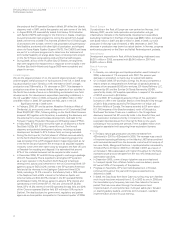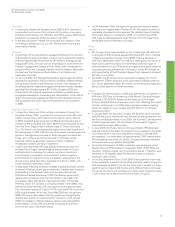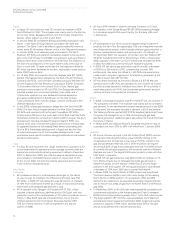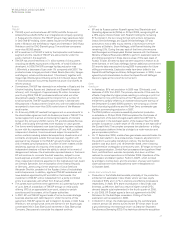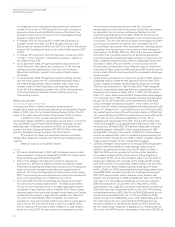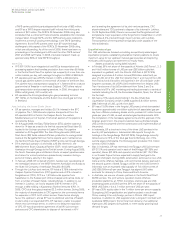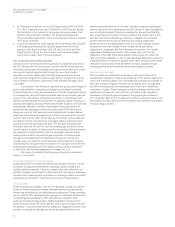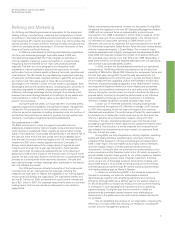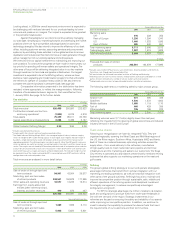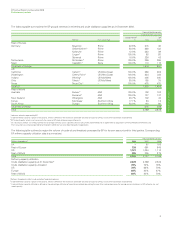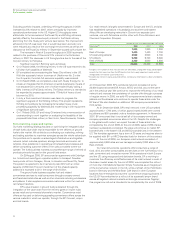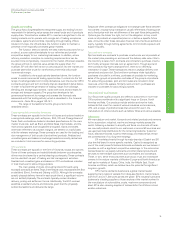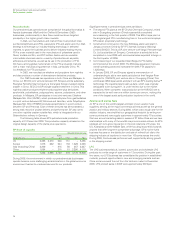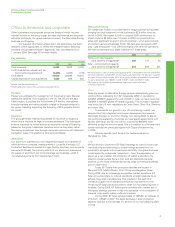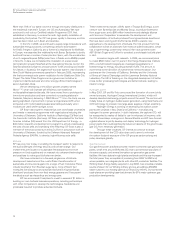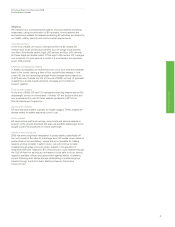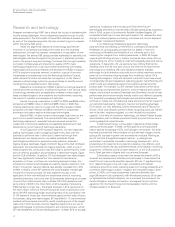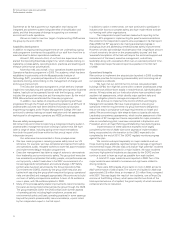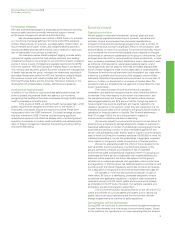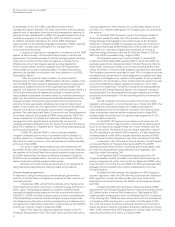BP 2008 Annual Report Download - page 35
Download and view the complete annual report
Please find page 35 of the 2008 BP annual report below. You can navigate through the pages in the report by either clicking on the pages listed below, or by using the keyword search tool below to find specific information within the annual report.
a
b
BP Annual Report and Accounts 2008
Performance review
Excluding portfolio impacts, underlying refining throughputs in 2008
increased by 5% relative to 2007, driven principally by improved
operational performance in the US. Higher US throughputs were
attributable to the recoveries at the Texas City and Whiting refineries,
partially offset by the reduced equity interest in the Toledo refinery
stemming from the Husky joint venture (see below). The improvement
achieved in the US was lower than it would have been as crude runs
were reduced as a result of the low-margin environment as well as the
disruption at the Texas City refinery in September caused by Hurricane Ike.
The increase in Rest of Europe throughputs in 2008 is primarily
related to the purchase of Chevron’s 31% interest in the Rotterdam
refinery in 2007. The decrease in UK throughputs is due to the sale of the
Coryton refinery to Petroplus.
Significant events in Refining were as follows:
• On 21 March 2008, the Whiting refinery in the US was restored to its
full clean fuel capability of 360mb/d.
• BP completed recommissioning the Texas City refinery in the US.
With the successful return to service of Ultraformer No. 3 in the
fourth quarter, the site’s full economic capability was restored.
• On 31 March 2008, we completed a deal with Husky Energy Inc. to
create an integrated North American oil sands business by means of
two separate joint ventures, one of which entailed Husky taking a
50% interest in BP’s Toledo refinery. The Toledo refinery is intended to
be expanded to process approximately 170mb/d of heavy oil and
bitumen by 2015.
• In July, a final investment decision was taken to progress the
significant upgrade of the Whiting refinery. This project repositions
Whiting competitively by increasing its Canadian heavy crude
processing capability by 260mb/d and modernizing it with equipment
of significant size and scale.
• On 17 March 2008, BP and Irving Oil entered into a memorandum of
understanding to work together on evaluating the feasibility of the
proposed Eider Rock refinery in Saint John, New Brunswick, Canada.
Fuels marketing, supply and logistics
Our fuels marketing strategy focuses on optimizing the integrated value
of each fuels value chain that is responsible for the delivery of ground
fuels to the market. We do this by co-ordinating our marketing, refining
and trading activities to maximize synergies across the whole value chain.
Our priorities are to operate an advantaged infrastructure and logistics
network (which includes pipelines, storage terminals and road or rail
tankers), drive excellence in operating and transactional processes and
deliver compelling customer offers in the various markets where we
operate. The fuels business markets a comprehensive range of refined oil
products primarily focused on the ground fuels sector.
On 29 August 2008, BP announced an agreement with Enbridge
Inc. to build and reconfigure a pipeline system to transport Canadian
heavy crude oil from Flanagan, Illinois, to Houston and Texas City, Texas.
The system is expected to be in service by late 2012 with an initial
capacity of 250mb/d. The joint investment of the phased capacity
additions is expected to be in the range of $1-2 billion.
The ground fuels business supplies fuel and related
convenience services to retail consumers through company-owned
and franchised retail sites as well as other channels including wholesalers
and jobbers. It also supplies commercial customers within the road and
rail transport sectors.
BP’s value creation in ground fuels is obtained through the
integration of the value chain from the refinery gates or import hubs
across retail and commercial channels to market. Convenience retail
offers are focused on delivering appealing convenience offers across the
various markets in which we operate, through the BP Connect, ampm
and Aral brands.
Our retail network is largely concentrated in Europe and the US, and also
has established operations in Australasia and southern and eastern
Africa. We are developing networks in China in two separate joint
ventures, one with Petrochina and the other with China Petroleum and
Chemical Corporation (Sinopec).
Number of retail sites operated under a BP brand
Retail sitesab 2008 2007 2006
UK 1,200 1,200 1,300
Rest of Europe 7,400 7,400 7,700
US (excluding jobbers) 2,500 2,500 2,700
US jobbers 9,200 9,700 9,600
Rest of World 2,300 2,500 2,600
Tot al 22,600 23,300 23,900
Changes in the number of retail sites over time are affected by, among other things, dealer/jobber-
owned sites that move to or from the BP brand as their fuel supply agreements expire and are
renegotiated in the normal course of business.
Excludes our interest in equity-accounted entities. Comparative information has been amended to
this basis.
At 31 December 2008, BP’s worldwide network consisted of some
22,600 locations branded BP, Amoco, ARCO and Aral, around the same
as in the previous year. We continue to improve the efficiency of our retail
network and increase the consistency of our site offer through a process
of regular review. In 2008, we sold 470 company-owned sites to dealers,
jobbers and franchisees who continue to operate these sites under the
BP brand. We also divested an additional 160 company-owned sites to
third parties.
At 31 December 2008, BP’s retail network in the US comprised
approximately 11,700 sites, of which approximately 9,200 were owned
by jobbers and 900 operated under a franchise agreement. In November
2007, BP announced that it would sell all of its company-owned and
company-operated convenience sites in the US. Despite the challenges
in the global credit market, we expect the sale of these sites to be
completed by the end of 2009. At the end of 2008, sales of 293 of sites
had been successfully completed. The sites will continue to market BP-
branded fuels in the eastern US and ARCO-branded fuels in the western
US. The franchise agreement has a term of 20 years and requires sites to
be supplied with BP- or ARCO-branded fuels for the term of the contract.
At the end of 2008, our European retail network consisted of
approximately 8,600 sites and we had approximately 2,300 sites in the
Rest of World.
Our retail convenience operations offer consumers a range of
food, drink and other consumables and services on the fuel forecourt in a
safe, convenient and innovative manner. With operations in both Europe
and the US, using recognized and distinctive brands, BP is working to
maximize the efficiency and effectiveness of its retail network in each of
its chosen market areas. By the end of 2008, we completed the roll-out
of more than 100 Marks & Spencer Simply Food sites as an integral part
of the convenience network in the UK, while a refresh of the Petit Bistro
brand in Germany and the Wild Bean Café brand in other European
locations has re-energized consumers’ convenience shopping choices. In
the US, BP has embarked on a roll-out of its successful ampm brand
across all targeted national markets as its single convenience flagship;
this programme roll-out is intended to be completed by the end of 2009.
34


